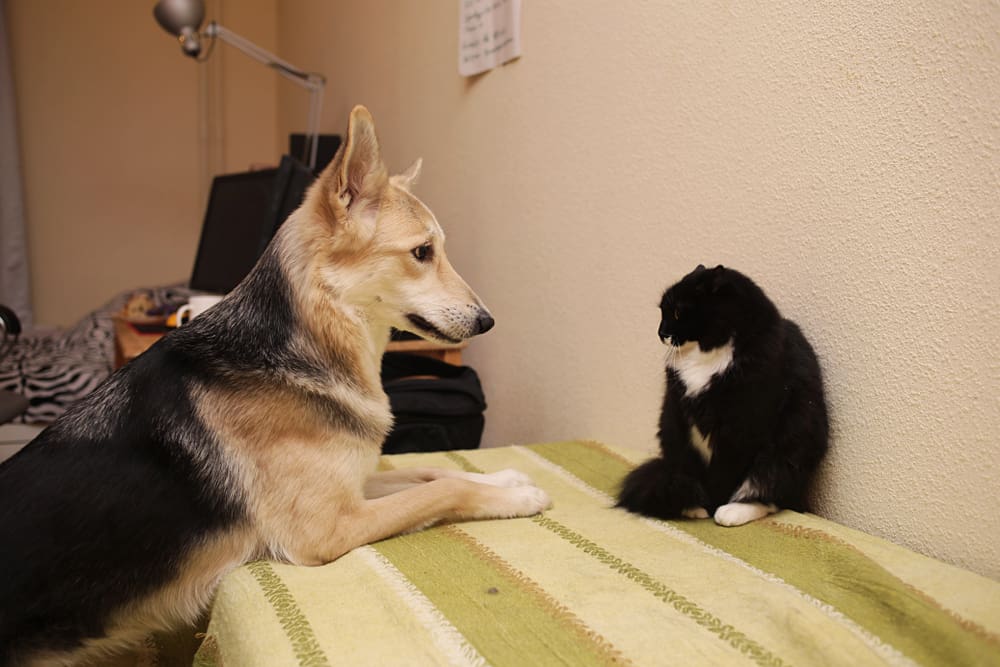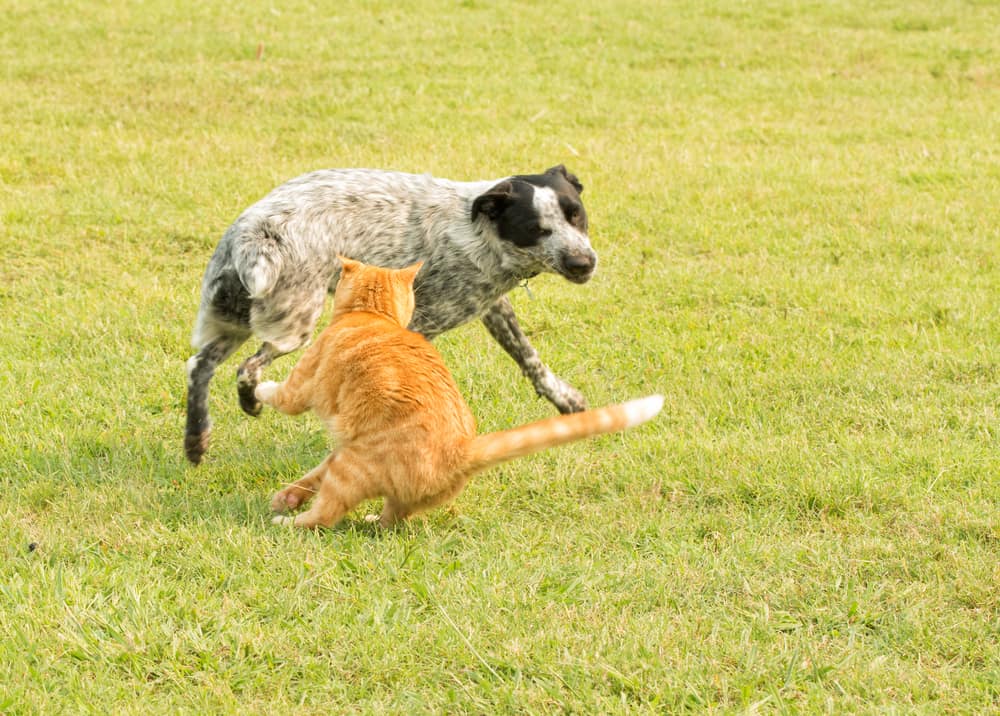Getting the Dog to Stop Attacking the Cat

Curiosity didn’t kill the cat; the dog did—but not if you learn to train him right.
Dogs have a natural tendency to chase cats, an in-built inclination dating back to the ancient era. Humans first started domesticating dogs as hunters and herders between 20,000 and 40,000 years ago, but we’ve only kept them as household pets for a relatively short time. It should come as no surprise, then, to discover our canine companions still cling to the predispositions of the past.
In this post, we’ll teach you how to reverse these millennia-old behavioral habits through eight handy hints and two step-by-step mini guides. Give these a read so you and your cat can finally start living in peace.
Why You Should Train Your Dog to Stop Attacking the Cat
As natural as the dog’s aggressive behavior may be, the last thing you want is constant conflict between your two beloved pets. While doggy chasing games are usually playful and harmless enough, there’s always the chance your canine could push it too far.
Put simply: training the dog to give kitty some space could be a matter of life or death.
Even if you’ve got a docile dog that isn’t physically capable of killing the cat, it could easily injure it in an attack. Your poor little kitty would suffer tremendously, and you’d be forced to foot the bill for the veterinary care—and that doesn’t come cheap these days.
And even if your dog is too timid to damage the cat, it’ll likely traumatize it with those incessant attacks. Plus, the persistent howls, screeches, and yelps are enough to drive the most passionate animal lover mad. It’s worth taking the time to train your dog for your own mental wellbeing.
The Benefits Go Beyond Your Cat
If you succeed in training your dog to stop attacking the cat, you’ll reap benefits well beyond your household. Your dog will be less inclined to act aggressively against smaller animals in the street, which will take the stress out of your regular walks. And should the neighbor’s cat wander over the fence into your yard, your four-legged friend will be more inclined to leave her in peace.
Well-trained dogs also tend to behave better around small children, which is essential for any parent with toddlers in tow. By training your dog to act relaxed around your cat, you could avoid the terrible possibility of it attacking a child.
8 Tips to Prevent Your Dog Attacking the Cat

Keep the following eight tips in mind to optimize your doggy training regime.
1. Set up a Safe Training Space
During training, you’ll need to gradually introduce both animals into the same space in a safe manner.
Keep them separated at all times while unsupervised, with each living in its own room. Allowing the two animals to enter into proximity without supervision is fraught with danger—it’s impossible to predict how your dog will respond.
To ensure the training process is as safe as possible for the cat, keep the dog on a short leash during their early encounters. Monitor your dog’s behavior and be ready to intervene if he should become too excited or aggressive. Return your dog and cat to their separate quarters between training sessions, and don’t let them mingle unsupervised until you’re confident they’ll get along.
To keep the two animals a safe distance apart during early encounters, consider using a playpen or a large crate to protect the cat. That way, they can become accustomed to each other’s presence without the risk of a violent altercation.
2. Spay or Neuter Your Dog
There are tons of tangible benefits associated with spaying or neutering a dog.
A spayed female won’t go into heat or become pregnant, and she’ll be less likely to contract diseases like uterine or breast cancer. A neutered male, on the other hand, will have less desire to run away from home and you won’t have to worry about testicular cancer.
Spaying and neutering are essential for training purposes as it makes both genders less aggressive towards other animals. De-sexed dogs tend to be less territorial and more inclined to view cohabitants (including cats) as companions rather than rivals.
If you haven’t already given your dog ‘the snip,’ it’s high time you did so.
3. Train From an Early Age (if Possible)
The easiest way to train a dog to stop attacking a cat is to introduce both animals into your home at the same time. Pets that grow up together tend to be less territorial and aggressive against one another—often, you won’t even have to train the dog at all.
Of course, that’s not possible if you already own a dog or cat. Just be aware that the longer you’ve had a dog in your home, the longer it’ll take to convince him to accept a new animal into its territory.
4. Positive Reinforcement Is Key
While it might be tempting to engage in negative reinforcement such as yelling at your dog, the process is counterproductive. Your dog will likely associate the punishment with the cat rather than its behavior, causing it to continue acting aggressively.
A far better training method is positive reinforcement, in which you reward your dog with treats and pats when it behaves well around the cat. That way, he learns to associate the cat with rewards rather than punishment and gradually modifies his behavior over time.
5. Don’t Let the Cat Run Away
While training your dog, avoid putting the cat in a situation where she feels the need to flee. A running cat will provoke the hunter/herder instincts in your dog, who’ll feel obliged to give chase. And that will make your dog feel justified about attacking the cat, and your cat rightfully wary of getting close to the dog.
Instead, introduce the two animals together gradually, with the dog on a leash and the cat in a secure area.
Of course, when you’re not present, you’ll need to ensure your cat has an easy escape route. Tall furniture such as shelves and cat condos are good spots for a cat to hide while the dog cools off.
6. Make the Cat Eat First
In the animal kingdom, the dominant beast eats first. One effective strategy for achieving a harmonious household is to feed your cat before the dog. That way, the dog starts to realize the cat is in charge and will be less likely to attack.
Set up a safe eating arrangement where your two pets can dine close by without getting into a fracas—the playpen will serve you well here, too. The process is known as food order desensitization and is a common hack in the pet training world.
7. Tire Your Dog Out
A dog that’s been cooped up inside all day will have oodles of excess energy, making him much more likely to act out against your cat. During the early training stages, take your dog for extra walks and encourage him to run around in the park.
Another top tip is to ensure your dog is readily entertained. Fill his room with stacks of puzzle toys and smother him with attention to keep the boredom at bay.
A mentally and physically exhausted dog will have far less interest in chasing the cat.
8. Consider Obedience Training
It’s much easier to persuade a well-trained dog to stop attacking the cat.
If you haven’t already looked into obedience training, now would be a good time to start. Even basic commands like “sit,” “stay,” and “leave” can make it so much easier to prevent the dog from attacking the cat.
It’s possible to do obedience training yourself, though time-poor pet owners might prefer to enlist a professional. A certified dog trainer can also assess your canine and offer useful advice on behavior modification strategies.
How Do I Get My Dog to Stop Attacking the Cat: Two Step-by-Step Guides

Follow these steps as often as possible—preferably at least once per day—until your dog stops exhibiting aggressive behavior towards the cat.
Guide 1: Gradual Introductions
- Put a leash on your dog and slowly enter into the cat’s territory.
- Approach the cat and monitor your dog’s reaction.
- Turn around and walk away from the cat.
- Reward the dog with a treat if it follows you without being aggressive.
- Leave the room and try again later if the dog acts aggressively (don’t punish him).
Guide 2: Playing Together
- Sit in the middle of the room with the cat on one side and the dog on the other.
- Monitor the dog’s behavior and reward him when he’s calm.
- Reward the dog for sniffing the cat in a non-aggressive way.
- Remove the dog from the room when he gets too excited.
Getting the Dog to Stop Attacking the Cat: Final Thoughts
Although it might take several weeks or even months, training your dog to stop attacking the cat will be well worth the effort. You won’t have to worry about the dog harming the cat, and you’ll relish in a more peaceful and harmonious household for years to come.
Keep our eight handy hints and two step-by-step guides in mind and begin your dog training journey today.




